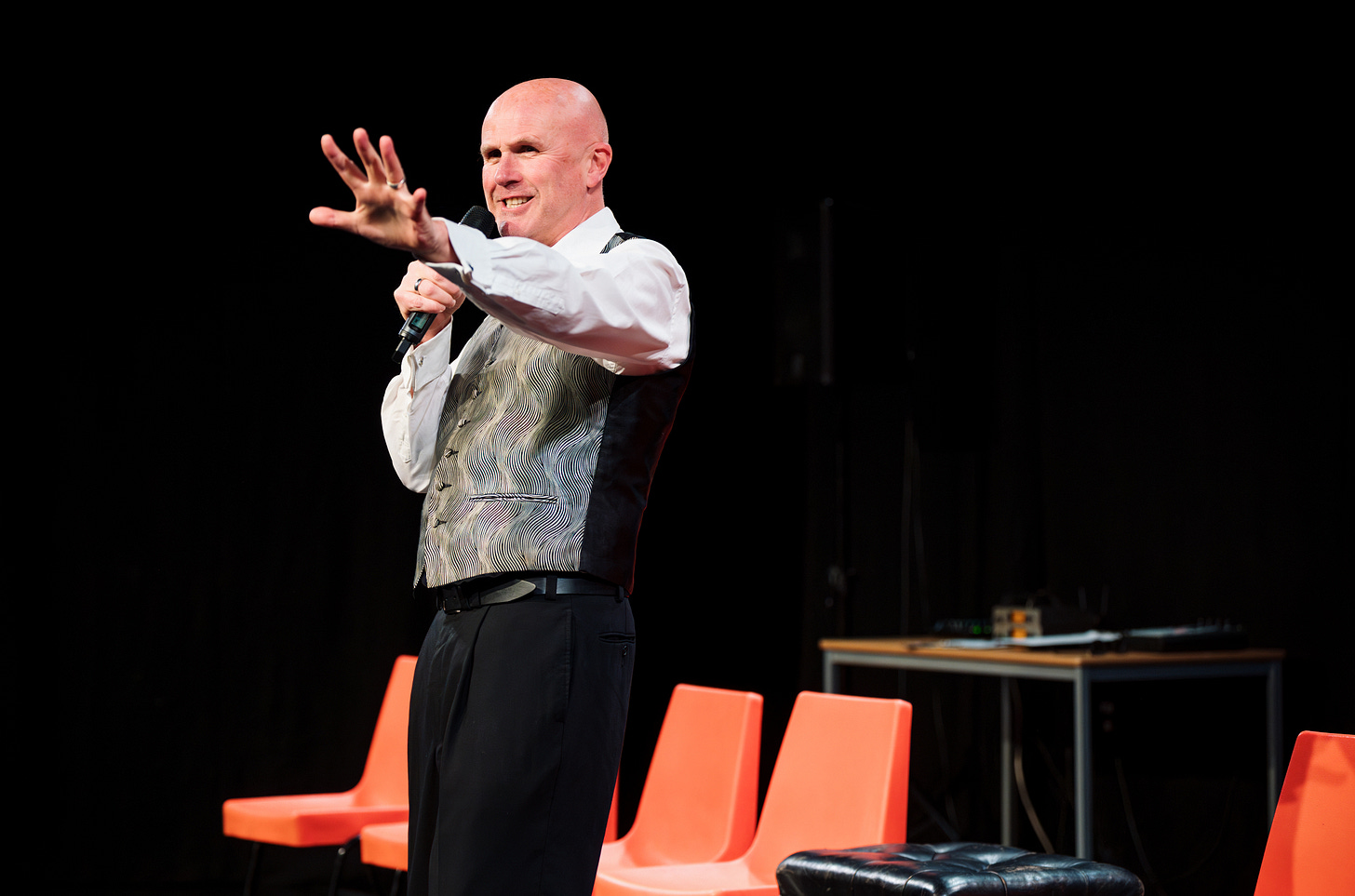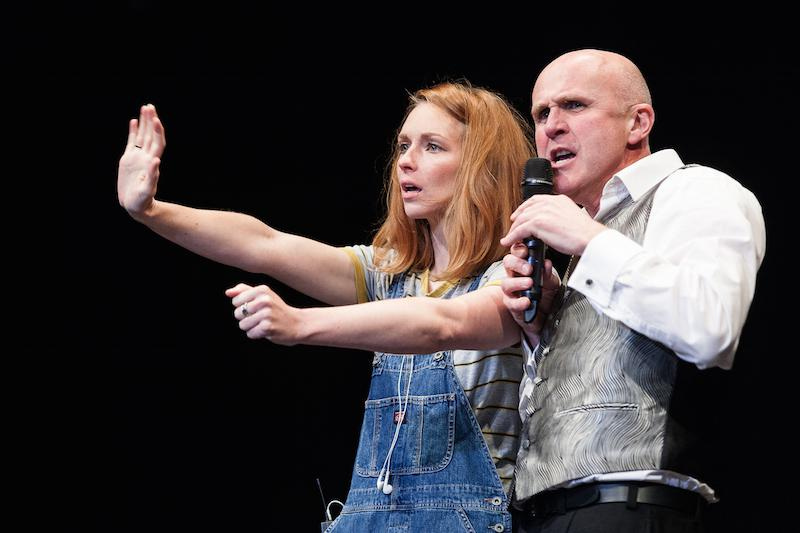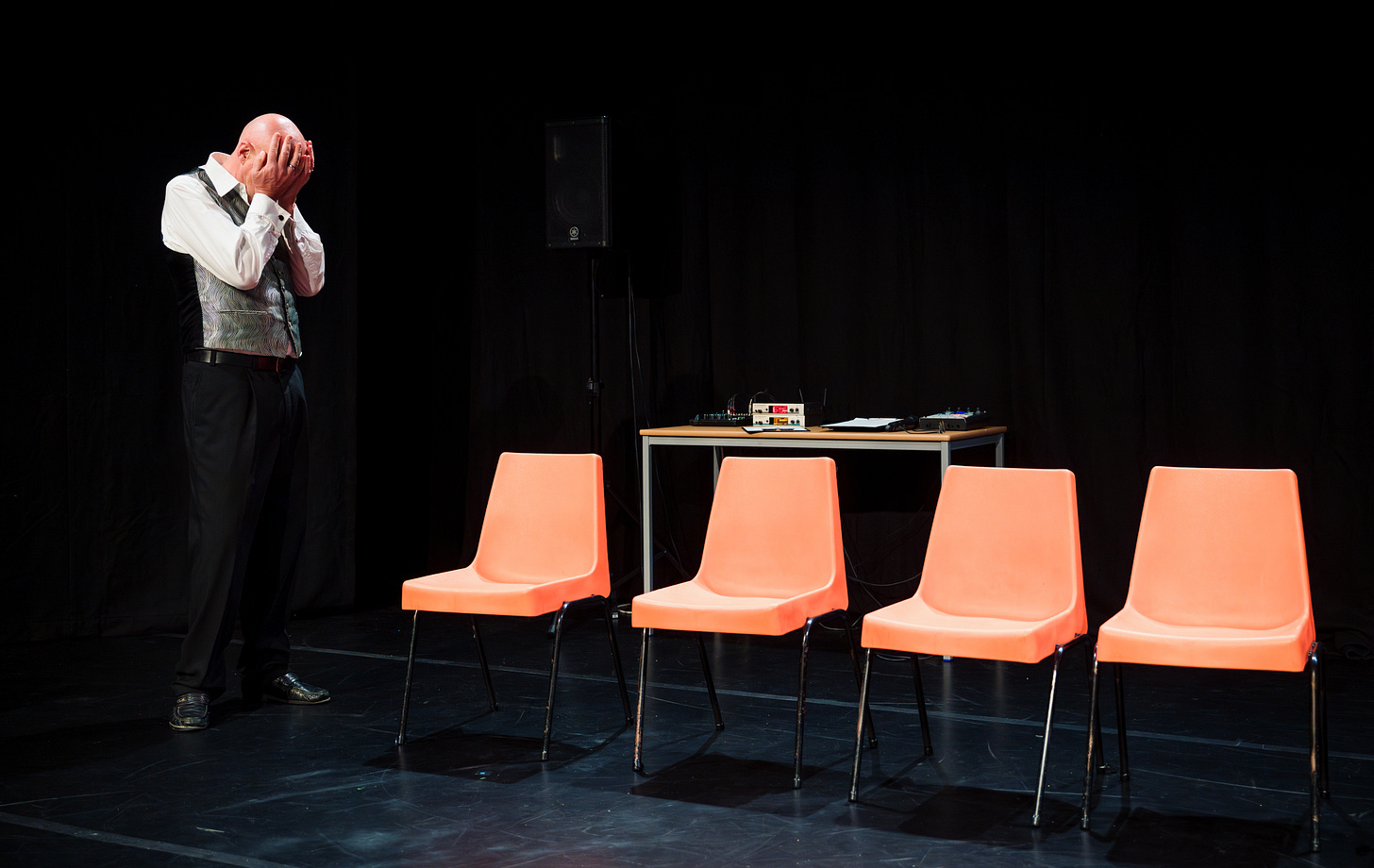This is the 100th edition of this newsletter. Since it launched in 2023, I have written about work from Germany, France, Denmark, Latvia, Norway. Belarus, Italy, Greece, Estonia, Bulgaria, the Netherlands, Ireland, Serbia, Sweden, Slovenia, Albania, Great Britain, Portugal, Bosnia and Herzegovina, Switzerland, Kosovo, Austria, Poland, Romania, Ukraine, the Faroe Islands and, erm, Peru. My interviewees have included Carolina Bianchi, Milo Rau, Chris Thorpe, Rikki Henry, Tue Biering, Nikita Milivojević, Jaz Woodcock-Stewart, Omar Elerian, Belarus Free Theatre’s Natalia Kaliada and almost everyone involved in the making of Three Kingdoms. I have spent a lot of time on buses, met some incredible artists and made a fair few friends.
There are now almost 1800 subscribers, which is lovely, a number of whom pay to support my writing, which is even lovelier. While the aim remains to keep this Substack largely paywall-free, going forwards there will be some more paid subscriber articles. This isn’t my preferred model but I need to make this sustainable. With that in mind, if you have been enjoying this newsletter and want to support it, you can currently do so for just £4 a month or £40 a year.
Now on to Tim Crouch…
In 2015 at the Traverse Theatre in Edinburgh and the Irish actor Aoife Duffin is about to perform in a play for which she has never read the script. There have been no rehearsals. Aside from a short briefing, she has no idea what will happen when she steps on stage. What happens is an act of transformation.
The play is An Oak Tree and by the time I saw it in Edinburgh in 2015, Crouch had been performing it for 10 years. The play consists of a dialogue between a hypnotist, played by Crouch, and the father of the girl he has killed in a car accident. A different actor plays the father at every performance, none of whom will have seen the text beforehand. Over the years Crouch has performed opposite actors including Frances McDormand, Alan Cumming, Simon McBurney. Alanis Morissette, Peter Dinklage and Mike Myers – there’s a full list here – and in Latvia, Lithuania, Germany, Russia, Portugal, the US and in Avignon under the stars. Now he’s bringing it back for a run at the Young Vic in London.
Crouch trained as an actor at the University of Bristol and the Central School of Speech and Drama in London, but turned to writing having become frustrated with UK theatre, both its adherence to realism and the way he felt it neglected the audience. He wrote his first play My Arm, in 2003, when he was 38. “I’d lost the joy in what I was doing as an actor,” he says. “Writing it was an escape hatch.” My Arm is a play about art, truth and someone who, at the age of 10, decides to live their life with one arm raised above their head, in which objects provided by the audience are used as the different characters in the play. My Arm did well in Edinburgh and international tour dates followed. (Here’s Crouch in the Guardian on the experience of watching his play being performed in German at the Nationaltheater Mannheim).
The text of My Arm, which was published by Faber and Faber, contained a page devoted to a fake production company that contained an announcement that their next show would be called An Oak Tree. The title comes from a conceptual artwork by Michael Craig-Martin which consists of a glass of water standing on a glass shelf and a notice explaining that "the actual oak tree is physically present but in the form of the glass of water."
Having set himself the task of writing a play called An Oak Tree, Crouch “genuinely had no idea what it would be, other than it would play on what I think is the foundation of all art, by turning one thing into something else.” In the end, he had the idea of taking Craig-Martin’s idea and flipping it, so that it is the tree that becomes something else; in the case of the play the oak tree becomes a man’s dead daughter.
In My Arm, Crouch was already exploring the idea of something on stage becoming something else and he wanted to push that idea further. Initially he considered writing the play for someone who wasn’t an actor. “I think I just got tired of watching actors act right,” he said. “My Arm was a release from that.” Theatre maker Andy Smith, one of the shows co-directors along with Crouch and Karl James, performed opposite Crouch while they were working on the play - the second actor is called Andy in the text – before they alighted on the idea of it being played afresh each night by someone unfamiliar with the text. “I wanted to do what I did in My Arm but with a human being. How can we prevent a human being from knowing too much about themselves and their meaning?” they asked. “Let's bring them in without them knowing the play.”
Crouch wrote the play relatively quickly, something he was able to do in part because he had set himself a set of very particular constrictions. When you are writing with restrictions, he says, “your brain immediately starts to solve the problems of those restrictions.”
Crouch devised different methods for guiding the second actor and controlling the performance. He speaks to them via an earpiece and sometimes he just feeds them the lines. Everything in the play is fixed. It’s all there on the page. “It’s all determined and yet at the same time not really determined at all,” as Catherine Love wrote in her review for Exeunt.
An Oak Tree taps into an actor’s instincts. ”A six-week rehearsal process will solidify an actor’s instinct or concretize it,” says Crouch. “Whereas with An Oak Tree, there is only instinct. It's really hard for your brain to process what’s happening from moment to moment. The play requires you to just be here.”
Ian Golding was the first person to play the role of the second actor opposite Crouch while it was still in rehearsals. They previewed the show in Mannheim, where Crouch had previously performed My Arm, and then at the Nightingale in Brighton, before opening at the Traverse in Edinburgh in 2005. Mark Ravenhill, Sandy Grierson, and Tom Brooke performed in that first Edinburgh run. It was presented as part of the British Council Showcase, which led to several international tour dates. He was approached by an American producer who said the play had broken his heart and he wanted to take it to New York; it went on to play the Barrow Street Theater in 2006. As the play’s reputation spread, the list of participants has grown to include A-listers and Hollywood stars (Frances McDormand sounds like an absolute blast), though ideally Crouch says, you want an actor with “theatre chops.”
Crouch is aware that the appearance of well-known actors creates “a hook that could possibly make the play commercial,” but in most iterations of the play outside the US they’ve managed to avoid letting audiences know who's performing in which show in advance. In any case, the way the play is written, with Crouch’s character explaining to the second actor that he killed their daughter with his car in the play’s first moments, “makes any notion of kind of famousness disappear. The audience very quickly understands that it's not what this is about.”
“You’re out of control, but you’re free.”
“I always thought the premise was completely terrifying and absolutely fascinating,” says actor Letty Thomas who appeared in the play’s 2023 run. “When the opportunity to do it came up, I felt suitably sick at the thought, but knew it wasn't something I could walk away from.”
Helen Monks, co-director of Lung Theatre, who also performed in An Oak Tree in 2023, felt similarly. ’Like the best things in life, you know it will be good for you in the long run, but the idea of it makes you want to throw up.”
US actor Kyle Secor, star of classic cop drama Homicide: Life on the Street, who performed in the show in 2010 at the Odyssey Theater in Los Angeles, wanted to be a part of it from the first time he heard about the play, to the point that when someone else dropped out of the LA run, he jumped at the chance to take their spot, but at the same time he describes it as having the potential to be “an actor’s worst nightmare.”
Nathan Queeley-Dennis, the Bruntwood Prize-winning playwright and actor who also performed in An Oak Tree during the 2023 run, was excited to be part of a piece that “has been performed since I was in primary school.” Having the opportunity to join such a prestigious list of performers was a large part of the appeal, but also for him as a performer it went deeper than that. “An Oak Tree is pure theatre,” he says, “the reason we love the form so much. You remove the other intangibles that can shroud your head, you have no choice then it’s just you, your fellow actor and an audience.”
For Monks the faint sense of nausea persisted until the day of the show when, she says, “I did consider faking norovirus, but as soon as I arrived at the theatre I felt immediately at peace. 100% because of Tim.”
For Secor the nightmare turned out to be, he says, “more like an active dream with Tim as the controlling entity.” He remembers “feeling a sense of awe from the moment I came on stage” along with “a sense of gratitude throughout it all, while also at certain times feeling like he was coercing me, but that it was all leading somewhere.”
Putting the second actor at ease is important to Crouch who always meets them beforehand to brief them. “I work really hard to support the actor, to make them feel supported and feel successful and feel free. I say repeatedly that you can't fuck the show up,” he says.
Monks loved the fact that “you get your own secret first act.” Secor says it really brought up questions for him about what a performance can be because “I felt like the performance began as soon as I entered the theatre space, it started well before we started doing the play. “
Monks remembers thinking at the time how Crouch had written a play that was, for him as an actor, the thing he’d most love to experience for himself but the nature of the play means he’ll never get to do it. Even worse, she says, “you're having to watch other actors get to do it night after night. I mean, what a masochist.”
Everyone describes the sense of feeling carefully guided through the process. “The way Tim guides you through it is balanced so finely, that you always feel both entirely held, and entirely free,” says Thomas. “There is no "supposed to" there is no "right way", by being there, and being you, and trusting Tim - you cannot get it wrong.”
“It is possibly the most open and vulnerable I have ever felt on a stage,” Thomas says, “because what he has concocted allows us so safely to get out of our own way, and truly experience the unknown, the dangerous, the terrifying. “
The actors are equipped with an earpiece so that Crouch can talk to them throughout and reassure them they are doing OK. For Monks. this was the most striking part. “I wish I could have him in my ear every time I'm acting in anything, talking over any internal voice of self-doubt. Imagine, just a whispering Tim Crouch following me around: 'wow Helen, you're just doing brilliant, just fantastic, you're amazing.' I think I would be unstoppable. We all deserve a Tim Crouch in our ears.”
“All the eyes are on you, but I never felt exposed,” says Queeley-Dennis, “you feel so safe with Tim, looking you in your eyes, speaking to you through your ear or just his presence in the room. Obviously the second actor is the spectacle, but Tim does so much on stage while performing, directing and at times stage managing the show. It felt like I was watching a performance myself.”
While Secor also talks and about being carefully guided and trusting Crouch, there’s a moment, he says, when Crouch walks off stage leaving the second actor alone and even though he tells them exactly what he’s going to do and they’re in the safety of the theatre space, there’s an element of danger there. “My wife was really angry about that part,” he says, a reaction he thinks illustrates the strength of the show and the way Crouch is “masterful in the way he makes you feel safe.” While performing he remembers looking at the audience and seeing people crying and laughing and clasping each other’s hands and not really understanding how or why that was happening. At the end of the performance, he remembers approaching Crouch and asking him: “What the fuck just happened? “
It’s a sentiment Queeley-Dennis echoes: “you don’t really know what’s happening, but you’re so glad that it is happening.” For him, performing the show “felt like an out of body experience.” The whole thing was, he says, “such a blur, but you sort of surrender yourself to the character, to the text and to Tim. None of the decisions you make are your own, but they are still you, you’re out of control but you’re free.”
There is something anti-virtuosic about An Oak Tree, says Crouch. The second actor is a vessel. The audience do the work. That’s not to say, he adds, that he doesn’t perform, “I'm absolutely a performer in my work, but I think An Oak Tree has taught me again and again, if you are direct and honest with the audience, they will come with you, they will fill in the gaps. They will do a huge amount. And that only happens if you do less.”
“Afterwards I recall feeling a great deal of freedom, and realising that acting wasn't everything that I thought it was, it could be so much broader,” says Secor. “Tim’s generosity of spirit really had a big effect on me,” he adds. “Being there for your fellow person, being there for the audience, being there not not just for that short amount of time you're on stage, but prior to and after the show.”
“As a performer it gave me a real theatrical catharsis,” says Queeley-Dennis. “It’s like pressing the reset switch on everything you’ve learnt or picked up prior. No time to refine, think, question or doubt yourself. All you have is your instinct and an actor’s instinct is an amazing and beautiful thing.”
“I sometimes think that Tim has solved theatre,” says Thomas. “I felt like a beautiful transaction had taken place, which was in its essence and details unrepeatable. Which is true of course, for every night at the theatre - not just An Oak Tree, but we can forget that so easily. It's gift to re-remind yourself of that every time you go onstage.”
An Oak Tree is at the Young Vic, London until 24 May and then Crouch will be performing I, Peaseblossom at the RSC from 28-31 May
This week in European theatre
A round-up of festivals, premieres and other upcoming events over the next seven days
Living Apartment Together – Renowned theatre company BERLIN marks its 20th anniversary with a new production about the lives of the residents of an apartment building, their stories projected on the side of an apartment building with audiences experiencing the show via headphones. The show will premiere at NT Gent, where director Yves Degryse is part of the artistic leadership team, on 8 May in Ghent.
[BLANk] – Maria Aberg first directed a version of Alice Birch’s play, which consists of 100 short scenes which can be performed in any order, at the Donmar Warehouse in 2019 Now Aberg returns to the text, for completely new version at Stockholm’s Dramaten, where it premieres on 8th May.
The Village - The new show by Fix+Foxy – the Danish creators of Dark Noon - uses video to examine themes of globalisation with a cast of performers from Copenhagen, L.A., Mumbai, Lagos and Istanbul. It opens at the TheaterRepublique/Revolver in Copenhagen on 8 May.
Cadela Força Trilogy – Chapter 2: The Brotherhood - Brazilian theatre maker Carolina Bianchi follows up The Bride and the Goodnight Cinderella, one of the most talked about shows of the last couple of years, with the second part of her trilogy about sexual violence. It has its world premiere on 9 may as part of the Kunstenfestivaldesarts in Brussels.
Thanks for reading! If you have any feedback, tips, or thoughts about this newsletter, you can reach me on natasha.tripney@gmail.com








